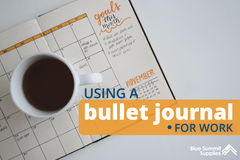Workplace injuries are extremely common in the US, and they’re no joke. Learn about the most common workplace injuries, how stretching can help prevent those injuries, and which stretches you can do to ease pain in your back, neck, legs, feet, and wrists.
Developing Injuries and Pain in the Workplace
Workplace injuries and pain are very common in the US. The Bureau of Labor Statistics (BLS) states that private industry employers reported 2.7 million nonfatal workplace injuries and illnesses in 2020. In terms of days missed, there were 1,176,340 nonfatal injuries and illnesses that caused a private industry worker to miss at least one day of work in 2020.
It’s in the best interest of the employer to promote awareness and provide support. It’s better to invest in wellness up front than to have someone off of work for an injury or pain that prevents them from working for weeks or months at a time.
As a worker, it’s also in your best interest to prioritize your health—even if your employers are not providing the support they should.
Pay attention to how you feel and where you are developing strain or pain. This is not something that should be ignored, as these strains can turn into more severe pain and could lead to injuries that require you to be off of work for a long time. In the worst cases, the injuries could prevent you from ever being able to do your job again.

Common Workplace Strains, Pains, and Injuries
The top three occupational injuries in 2020 were:
- Exposure to Harmful Substances or Environments (424,360 reported injuries)
- Overexertion, Bodily Reaction (255,490 reported injuries)
- Falls, Slips, Trips (211,640 reported injuries)
These three occupational injuries accounted for more than 75% of all nonfatal injuries and illnesses involving days away from work in 2020. Before 2020 and the COVID-19 pandemic, Exposure to Harmful Substances or Environments was ranked at #6.
So, before COVID-19, overexertion resulting in musculoskeletal system and connective tissue diseases and disorders (MSDs) was the most common. MSDs are extremely common in the workplace.

Here are some examples of MSDs:
- Back pain
- Carpal tunnel syndrome (CTS)
- Sprains, strains, and tears
- Repetitive strain injury (RSI)
The difficult thing about CTS, RSI, and other sprains and strains is they can be difficult to notice right away as they develop over time. If dismissed as mild or left untreated, these injuries will continue to get worse, resulting in more time away from work, and in the worst cases, corrective surgery.
If you work in a factory, in construction, or in another industry that requires you to be on your feet all day and do a lot of heavy lifting, avoiding workplace injuries necessitates constant vigilance. Back pain and strain can sneak up on you, as their causes aren’t always obvious or dramatic. For example, if you work in a warehouse, you can suffer back pain just from spending all day walking on a hard concrete floor.
If you work in an office, you may think you’re generally pretty safe from workplace injuries, but that’s far from the truth. Office workers often suffer wrist pain from typing, as well as neck and back pain from staring at a computer all day.
It’s important to remember that workplace injuries do not have to happen dramatically. Most injuries occur just from performing the regular activities of your job, day in and day out.
If you type all day, every day, it will strain the muscles, nerves, and tendons in your hands, fingers, arms, and wrists. Any repetitive action causes strain and pain. While the phrase, “No Pain, No Gain,” may sound tough and cool, it’s the opposite that’s true.
Pain is your body’s way of telling you something is wrong. If an action you perform every day is causing you pain, you won’t gain anything by ignoring it; all you’ll get in return is more pain and, potentially, surgery.
📚Learn more: How to Manage and Mitigate Wrist Pain When Typing

Finding Time to Stretch
With so much going on, it can be tough to find the time for one thing more. Between your career, family life, and the pervasive threat of COVID-19, isn’t there enough on your plate already?
While it may seem like a waste of time and just another burden on your already overburdened schedule, consider how much less time you’ll have if you suffer from chronic pain or a workplace injury. It’s best to invest the time into your health and safety now by building stretching into your daily routine.
The morning, just after you wake up, is a great time to stretch. Your body has been immobile for (ideally) 7-9 hours, so it’s understandably a little stiff. Give yourself some much-needed TLC by adding ten minutes of stretching to your morning routine.
☕️ Don’t have a morning routine? Learn How to Craft a Mindful Morning Routine (With Checklist)
Another great time to stretch is during your work breaks. Instead of turning to your phone or the latest news feed, find a space to do a little light stretching.
Scrolling through Instagram and Facebook, reading up on the latest ecological disaster, or checking COVID-19 numbers isn’t relaxing—it’s agitating. And considering there’s not much you as an individual can do on your lunch break about what people post, why not make your break constructive by helping out your body?
After work is another great time to stretch. We get it—you want to get home and stop thinking about work, but after a long day, you need to give your body some much-needed time and attention. Even if it feels relaxing in the moment, plopping yourself on the couch isn’t doing your body any favors. Studies show that people who sit for more than eight hours a day with no physical activity have a risk of dying similar to the fatality risks posed by obesity and smoking.

Best Stretches for Office Workers
For office workers, the best stretches you can do are for your wrists, neck, and back. In addition to stretching during your breaks, you can also work in some stretches while you wait for coffee to brew or while you heat up your lunch.
🤷 For most of us, there’s just no way around sitting for most of the day. Luckily, we reviewed The Best Office Chair for Back Pain.
If you do a lot of typing, it’s a good idea to stretch your wrists and hands throughout the day and right before you type. For example, a simple stretch you can do for your hands is called “spiders doing pushups in the mirror.”
Imagine a spider doing pushups on a mirrored surface. Start with your fingertips touching and pointing down to the floor. Spread your fingers as far apart as you can, then steeple your fingers by separating the palms of your hands but keeping your fingers together. It’s a simple and discrete stretch you can do regardless of where you are in the office or what you’re doing.
🖐 Looking for more ways to stretch your back, neck, hands, and wrists? Here are some simple hand and wrist stretches and some simple neck and back stretches.

Best Stretches for Working on Your Feet All Day
Whether you work in a factory, a warehouse, a hospital, or in retail, working on your feet all day can be a pain—literally. Standing all day taxes your knees, feet, heels, calf muscles, and back. Plantar fasciitis is a very common complaint that affects a great number of people. It’s heel pain that develops as a result of inflammation in the tissue that connects the heel bone and toes.
A simple exercise you can do to promote circulation in your calf muscles to prevent plantar fasciitis and other similar issues is the standing lunging calf stretch. To do this stretch, stand just a step away from the wall. Get yourself in a lunge position by placing your palms flat against the wall, stepping your right foot back, and bending your front knee. Keep your toes pointed forward and push your right heel toward the ground until you feel a stretch in your calf. Hold this position, and then switch legs.
👣 Looking for more ways to stretch? Here are some simple leg and foot stretches you can practice at home or at work.

Best Stretches for Lower Back Pain
When we stand or sit all day, it’s easy to slouch our shoulders and develop poor posture, which puts strain on our back muscles and can cause chronic lower back pain. One of the best stretching exercises for lower back pain, and arguably the most traditional yoga pose, is the Child’s Pose.
To perform the Child’s Pose, get on your hands and knees and rest your hips on your heels. As you fold forward, hinge at your hips, and walk your hands out in front of you, resting your stomach on your thighs. Extend your arms out in front of you and turn your palms so that they face the ceiling. Breathe deeply for one minute, focusing your breath on any areas of tension.
Since this pose requires you to get on the ground and point your butt out for all to see, this is an exercise best reserved for the home. Ensure you use a carpeted surface or a yoga mat so that you don’t hurt your knees. The Child’s Pose relaxes your body and helps to loosen up tight lower back muscles.
💪 Looking for more ways to loosen up a tight back? Try this simple stretching routine for beginners.
Prioritize Your Wellness
💡 Preventing Burnout in the Workplace: Actionable Strategies for Employees and Employers
💡 How to Manage Office Scents For Employees Sensitive to Smell
Are you passionate about wellness? Follow our workplace blog for the latest trends, healthy hacks, product comparisons, and more.
If you have any questions or want to talk to someone about our products or content, send us an email or connect with us on Twitter, Facebook, or Instagram.
 For more informative articles about office supplies, subscribe to our email newsletter!
For more informative articles about office supplies, subscribe to our email newsletter!
Never fear, you won't begin receiving daily sales emails that belong in a spam folder. Instead, we promise a fun weekly roundup of our latest blog posts and great finds from across the web. And if you lose interest, it's always easy to unsubscribe with a single click.










